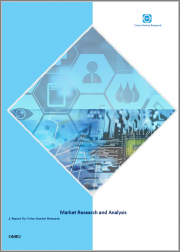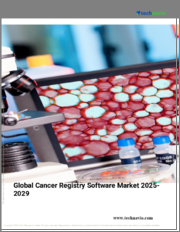
|
시장보고서
상품코드
1380247
세계의 암환자 등록 소프트웨어 시장(2023-2030년)Global Cancer Registry Software Market 2023-2030 |
||||||
세계 암환자 등록 소프트웨어 시장은 예측 기간 동안 연평균 10.5%의 높은 성장률을 보일 것으로 예상됩니다. 암 유병률 증가, 의료 질 향상, 주요 업체들의 최근 시장 개척과 함께 의료 비용 절감은 세계 암환자 등록 소프트웨어 시장의 성장을 가속하고 있습니다. 세계보건기구(WHO)에 따르면 암은 세계 주요 사망 원인으로 2020년 사망자 수는 약 1,000만 명, 사망자 6명 중 1명을 차지할 것으로 예상됩니다. 가장 흔한 암은 유방암, 폐암, 대장암, 전립선암 등입니다. 또한 2021년 7월에 업데이트된 국제암연구소(IARC)의 추정에 따르면, 2040년까지 세계 암 부담은 세계적으로 2,750만 명의 새로운 암 환자와 1,630만 명의 사상자가 발생할 것으로 예상됩니다. 이러한 높은 부담은 암 유병률 및 치료 관련 동향을 파악하는 데 큰 도움이 되기 때문에 암환자 등록 소프트웨어에 대한 수요를 증가시킬 것으로 보입니다.
높은 암 발병률과 암환자 등록 소프트웨어의 급속한 보급으로 시장은 성장할 가능성이 높습니다. 그러나 환자 데이터의 프라이버시 및 보안에 대한 우려는 시장 성장을 억제하는 요인으로 작용할 것으로 보입니다. 그러나 이 소프트웨어의 보급에 대한 정부의 참여가 증가함에 따라 세계 암환자 등록 소프트웨어 시장 성장에 유리한 기회를 제공할 것으로 보입니다.
부문별 전망
병원 및 의료현장이 세계의 암환자 등록 소프트웨어 시장에서 상당한 점유율 차지
2022년 세계 암환자 등록 소프트웨어 시장에서 병원 및 클리닉은 상당한 점유율을 차지했습니다. 병원에서 암 관련 시술이 증가함에 따라 이 지역 시장의 높은 점유율에 기여하고 있습니다. 환자들은 병원을 1차 의료 센터로 믿고 있으며, 이는 이 시장 부문의 성장을 주도하고 있는 것으로 보입니다. 스리랑카는 세계보건기구(WHO)의 동남아시아 지역 회원국 중 하나이며, 국제암연구소(IARC)와 인도 뭄바이의 타타 기념 센터에 위치한 IARC 지역 허브에서 암 등록에 대한 기술 지원을 받고 있습니다.
암 등록 기록의 데이터 관리를 위해 스리랑카 국가 암 등록(SLNCR)은 IARC가 개발한 오픈소스 등록 소프트웨어 도구인 CanReg5를 사용하고 있으며, SLNCR은 전국에 있는 25개 센터로부터 데이터를 받고 있습니다. 지구 종합병원(아비사웰라), 주 종합병원(바두라), 지구 종합병원(치라우), 교육병원(칼타람), 지구 종합병원, 종합병원(바브니아), Apeksha 병원(국립암연구소)이 현재 암환자 등록 소프트웨어를 사용하는 스리랑카의 주요 병원입니다.
지역별 전망
세계 암환자 등록 소프트웨어 시장은 북미(미국 및 캐나다), 유럽(이탈리아, 스페인, 독일, 프랑스, 기타), 아시아태평양(인도, 중국, 일본, 한국, 기타), 기타 지역(중동 및 아프리카, 라틴아메리카)으로 세분화되어 있습니다.
아시아태평양이 세계 암환자 등록 소프트웨어 시장에서 가장 높은 성장세를 보이고 있습니다.
이 지역의 성장은 헬스케어 분야에서의 기술 도입 증가에 기인합니다. 또한, 이 지역의 암 발병률이 증가하면서 더 나은 치료를 위해 암 패턴을 식별하기 위한 암환자 등록 소프트웨어의 채택이 촉진되고 있습니다. Programme(ICMR-NCRP)에 따르면, 정부는 의회에 2022년 1,770만 달러에서 2025년 1,900만 달러로 증가할 것이라고 보고했습니다. 예를 들어, 인도 정부의 공공정책 싱크탱크인 NITI Aayog는 생명공학부와 공동으로 이미지 바이오뱅크 구축을 목표로 하고 있으며, 20,000명 이상의 환자 프로파일에 대한 암 관련 병리 및 방사선 이미지 데이터베이스를 구축할 계획입니다. 이러한 이미지는 암 등록을 위한 거대한 데이터베이스를 구축하여 지역 시장의 성장을 가속하고 있습니다.
목차
제1장 보고서 개요
- 업계 현황 분석과 성장 가능성 전망
- 조사 방법과 툴
- 시장 내역
- 부문별
- 지역별
제2장 시장 개요와 인사이트
- 조사 범위
- 애널리스트 인사이트와 현재 시장 동향
- 주요 조사 결과
- 추천 사항
- 결론
제3장 경쟁 구도
- 주요 기업 분석
- IBM Corp.
- 개요
- 재무 분석
- SWOT 분석
- 최근 동향
- Siemens Healthineers
- 기업 개요
- 재무 분석
- SWOT 분석
- 최근 동향
- McKesson Corp.
- 개요
- 재무 분석
- SWOT 분석
- 최근 동향
- 주요 전략 분석
제4장 시장 세분화
- 세계의 암환자 등록 소프트웨어 시장 : 데이터베이스 유형별
- 상용 데이터베이스
- 공개 데이터베이스
- 세계의 암환자 등록 소프트웨어 시장 : 전개 모델별
- 클라우드 기반
- 온프레미스
- 세계의 암환자 등록 소프트웨어 시장 : 최종사용자 산업별
- 정부 및 써드파티
- 민간기업
- 병원 및 진료소
- 기타
제5장 지역별 분석
- 북미
- 미국
- 캐나다
- 유럽
- 영국
- 독일
- 이탈리아
- 스페인
- 프랑스
- 기타 유럽
- 아시아태평양
- 중국
- 인도
- 일본
- 한국
- 기타 아시아태평양
- 세계 기타 지역
제6장 기업 개요
- C/NET Solutions
- Conduent, Inc.
- Electa
- Electronic Registry System, Inc.
- Epic Systems
- ERS, Inc.
- himagine solutions
- Inspirata, Inc.
- NeuralFrame, Inc.
- Onco, Inc.
- Ordinal Data Inc
- Redsson, Ltd.,
- Rocky Mountain Cancer Data Systems
Title: Global Cancer Registry Software Market Size, Share & Trends Analysis Report, By Deployment Model (On-Premise, Cloud-based), By Database Type (Commercial Database, Public Database), By End-User Industry (Government & Third Party, Private Payers, Hospital & Medical Practice, Others)Forecast Period (2023-2030).
Global cancer registry software market is anticipated to grow at a significant CAGR of 10.5% during the forecast period. The increasing prevalence of cancer, improving quality of care, and reducing healthcare costs along with recent developments by key players are driving the growth of the global cancer registry software market. According to the World Health Organization, Cancer was a leading cause of mortality worldwide, accounting for nearly 10 million mortalities in 2020, or nearly one in six casualties. The most common cancers include breast, lung, colon rectum, and prostate cancers. Additionally, according to estimates from the International Agency for Research on Cancer (IARC) updates from July 2021, by 2040, the global burden of cancers is expected to grow to 27.5 million new cancer cases and 16.3 million casualties globally. Such high burdens will increase the demand for cancer registry software as it would provide significant benefits in identifying the trend related to the prevalence and treatment of cancer.
With high cancer prevalence and rapid adoption of cancer registry software, the market is likely to grow. However, privacy and security concerns for patient data will be a restraint in the market growth. However, the growing involvement of the government in the promotion of this software is likely to offer lucrative opportunities for the growth of the global cancer registry software market.
Segmental Outlook
The global cancer registry software market is segmented based on deployment model, database type, and end-user industry. Based on the deployment model, the market is segmented into cloud-based and on-premises. Based on database type, the market is segmented into commercial databases and public databases. Based on the end-user industry, the market is segmented into government & third party, private payers, hospital & medical practice, and others.
Hospital and Medical Practice Held a Considerable Share in the Global Cancer Registry Software Market
Hospital & medical practice held a considerable share of the global cancer registry software market in 2022. The rising number of cancer-related procedures in hospitals is contributing to the high share of the regional market. Patients have been relying on hospitals as primary care centers, which is likely to drive the growth of this market segment. Sri Lanka is one of the Member States of the World Health Organization's South-East Asia Region and receives technical support for cancer registration from the International Agency for Research on Cancer (IARC), and the IARC Regional Hub based at the Tata Memorial Centre in Mumbai, India.
For data management of cancer registry records, the Sri Lanka National Cancer Registry (SLNCR) uses the open-source registry software tool, CanReg5, as developed by IARC. The SLNCR has received data from 25 centers located across the country. District General Hospital, Avissawella, Provincial General Hospital, Badulla, District General Hospital, Chilaw, Teaching Hospital, Kalutaram, District General Hospital, General Hospital, Vavuniya, and Apeksha Hospital (National Cancer Institute) are the major Sri Lankan Hospitals that are currently using cancer registry software.
Regional Outlook
The global cancer registry software market is further segmented based on geography, including North America (the US and Canada), Europe (Italy, Spain, Germany, France, and others), Asia-Pacific (India, China, Japan, South Korea, and others), and the Rest of the World (the Middle East & Africa and Latin America).
Asia-Pacific to exhibit Highest Growth in the Global Cancer registry software Market
Regional growth is attributed to an increasing adoption of technology in the healthcare sector. Also increasing cases of cancer in the region is promoting the adoption of cancer registry software to identify the pattern of cancer for its better treatment. According to the Indian Council of Medical Research-National Cancer Registry Programme (ICMR-NCRP), the government informed Parliament the number of cancer cases in the country is projected to go up from $17.7 million in 2022 to $19.0 million in 2025. For instance, NITI Aayog, the public policy think tank of the Indian Government, aims to build an Imaging Biobank in association with the Department of Biotechnology, wherein it will create a database of cancer-related pathology and radiology images of more than 20,000 profiles of patients. Such images are creating a huge database for cancer registries; thereby driving the regional market growth.
Market Players Outlook
The major companies serving the global cancer registry software market include: IBM Corp., Elekta, McKesson Corp., Siemens Healthineers, and Epic Systems among others. The market players are considerably contributing to the market growth by the adoption of various strategies, including mergers and acquisitions, partnerships, collaborations, funding, and new product launches, to stay competitive in the market. For instance, in September 2022, Electronic Registry Systems (ERS) Inc. and Nursenav Inc., an oncology navigation software, partnered to integrate their flagship software solutions, CRStar and CONNECT. This integration leverages cancer registry workflows and data collection to support services provided by oncology navigation. The integration between CRStar and CONNECT supports the creation of survivorship care plans by transmitting the diagnosis and treatment data directly into the patient's plan in CONNECT.
The Report Covers:
- Market value data analysis of 2022 and forecast to 2030.
- Annualized market revenues ($ million) for each market segment.
- Country-wise analysis of major geographical regions.
- Key companies operating in the global cancer registry software market. Based on the availability of data, information related to new product launches, and relevant news is also available in the report.
- Analysis of business strategies by identifying the key market segments positioned for strong growth in the future.
- Analysis of market-entry and market expansion strategies.
- Competitive strategies by identifying 'who-stands-where' in the market.
Table of Contents
1. Report Summary
- Current Industry Analysis and Growth Potential Outlook
- 1.1. Research Methods and Tools
- 1.2. Market Breakdown
- 1.2.1. By Segments
- 1.2.2. By Region
2. Market Overview and Insights
- 2.1. Scope of the Report
- 2.2. Analyst Insight & Current Market Trends
- 2.2.1. Key Findings
- 2.2.2. Recommendations
- 2.2.3. Conclusion
3. Competitive Landscape
- 3.1. Key Company Analysis
- 3.2. IBM Corp.
- 3.2.1. Overview
- 3.2.2. Financial Analysis
- 3.2.3. SWOT Analysis
- 3.2.4. Recent Developments
- 3.3. Siemens Healthineers
- 3.3.1. Overview
- 3.3.2. Financial Analysis
- 3.3.3. SWOT Analysis
- 3.3.4. Recent Developments
- 3.4. McKesson Corp.
- 3.4.1. Overview
- 3.4.2. Financial Analysis
- 3.4.3. SWOT Analysis
- 3.4.4. Recent Developments
- 3.5. Key Strategy Analysis
4. Market Segmentation
- 4.1. Global Cancer Registry Software Market by Database Type
- 4.1.1. Commercial Database
- 4.1.2. Public Database
- 4.2. Global Cancer Registry Software Market by Deployment Model
- 4.2.1. Cloud Based
- 4.2.2. On-Premises
- 4.3. Global Cancer Registry Software Market by End-User Industry
- 4.3.1. Government & Third Party
- 4.3.2. Private Players
- 4.3.3. Hospital & Medical Practice
- 4.3.4. Others
5. Regional Analysis
- 5.1. North America
- 5.1.1. United States
- 5.1.2. Canada
- 5.2. Europe
- 5.2.1. UK
- 5.2.2. Germany
- 5.2.3. Italy
- 5.2.4. Spain
- 5.2.5. France
- 5.2.6. Rest of Europe
- 5.3. Asia-Pacific
- 5.3.1. China
- 5.3.2. India
- 5.3.3. Japan
- 5.3.4. South Korea
- 5.3.5. Rest of Asia-Pacific
- 5.4. Rest of the World
6. Company Profiles
- 6.1. C/NET Solutions
- 6.2. Conduent, Inc.
- 6.3. Electa
- 6.4. Electronic Registry System, Inc.
- 6.5. Epic Systems
- 6.6. ERS, Inc.
- 6.7. himagine solutions
- 6.8. Inspirata, Inc.
- 6.9. NeuralFrame, Inc.
- 6.10. Onco, Inc.
- 6.11. Ordinal Data Inc
- 6.12. Redsson, Ltd.,
- 6.13. Rocky Mountain Cancer Data Systems















